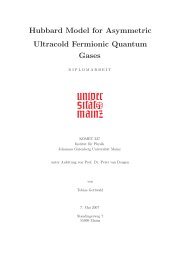5 Hirsch-Fye quantum Monte Carlo method for ... - komet 337
5 Hirsch-Fye quantum Monte Carlo method for ... - komet 337
5 Hirsch-Fye quantum Monte Carlo method for ... - komet 337
Create successful ePaper yourself
Turn your PDF publications into a flip-book with our unique Google optimized e-Paper software.
5.24 Nils Blümer<br />
(a) 0.5<br />
(b)<br />
G(τ)<br />
0.4<br />
0.3<br />
0.2<br />
0.1<br />
A(ω)<br />
0.3<br />
0.2<br />
0.1<br />
0<br />
-6 -4 -2 0<br />
ω<br />
2 4 6<br />
U=4.0<br />
U=4.7<br />
U=5.5<br />
0<br />
0 5 10<br />
τ<br />
15 20<br />
A(|ω|)<br />
0.4<br />
0.3<br />
0.2<br />
0.1<br />
α=4<br />
α=40<br />
α=400<br />
α=4000<br />
0<br />
0 1 2 3<br />
ω<br />
4 5 6<br />
Fig. 14: Example <strong>for</strong> analytic continuation of Green functions using the maximum entropy<br />
<strong>method</strong> (MEM). (a) While the Green functions (Bethe lattice, T = 0.05) are featureless at all<br />
interactions and differ mainly by their value and curvature near τ = β/2, the spectra derived<br />
using MEM (inset) show clearly the narrowing and disappearance of the quasiparticle peak<br />
with increasing interaction U. (b) Impact of the weighing factor α on the MEM result <strong>for</strong><br />
U = 4.0.<br />
Spectra<br />
Spectra and optical conductivity data also shed light on systems near an MIT and are essential<br />
input <strong>for</strong> quantitative comparisons with experiments. Un<strong>for</strong>tunately, an analytic continuation is<br />
needed <strong>for</strong> imaginary-time based algorithms (such as the HF-QMC <strong>method</strong>) which is inherently<br />
unstable. In App. B, we discuss the maximum entropy <strong>method</strong> (MEM) which regularizes the<br />
procedure by a constraint on the smoothness of the spectrum (quantified by the entropy function).<br />
As seen in Fig. 14 the essential correlation physics is much more transparent on the level<br />
of the spectra than on that of the imaginary-time Green function. Thus, even significant ef<strong>for</strong>ts<br />
in MEM related questions appear well spent.<br />
4.2 Estimation of errors and extrapolation∆τ → 0<br />
As we have already mentioned, any “raw” estimate of an observable measured at some iteration<br />
using HF-QMC contains various sources of errors: (i) the statistical MC error, (ii) the convergency<br />
error associated with incomplete convergence of the self-consistency cycle, and (iii) the<br />
discretization error stemming both from the Trotter decoupling and the approximate Fourier<br />
trans<strong>for</strong>mations discussed in Sec. 2 and Sec. 3, respectively.<br />
The first two errors can be treated at equal footing when we compute the observables at each<br />
iteration and extract averages from their “traces” (i.e. their functional dependence as a function<br />
of iteration number) as depicted in Fig. 15a <strong>for</strong> the double occupancy D. We see that the<br />
measurements fluctuate significantly <strong>for</strong> each value of ∆τ; the amplitude of such fluctuations<br />
can be controlled by the number of sweeps. Also apparent is a gradient in the initial iterations<br />
<strong>for</strong> the largest discretization shown, ∆τ = 0.20. It is clear that such lead-in data should not













